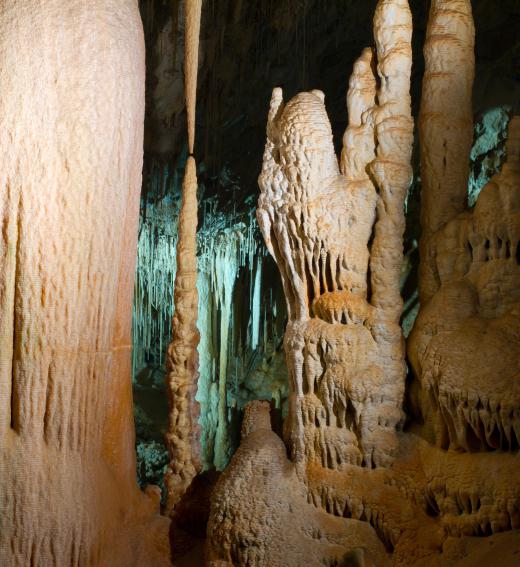What is Calcite?
 Dee Saale
Dee Saale
Calcite, or calcium carbonate, is one of the most common minerals on earth. It can be found in large, sedimentary rock masses and in limestone. It can also be found in cave deposits, such as stalactites, stalagmites, and incrustations. Since it is so common, it is nearly impossible to specify every occurrence of calcite; however, there are a few well-studied localities where calcite crystals can be found. These localities include the Harz Mountains, Germany; Lancashire, England; Joplin, Missouri; and Guanajuato, Mexico.
Depending on where calcite is found, it can range in color from yellow to colorless. There have been some specimens found where the mineral was tinted green, blue, gray, and even red. If it is brown or black in color, it is considered to be impure.
The luster of calcite also varies from vitreous or glass-like to resinous. When found in large masses, it can even appear dull. In addition, since finger can easily scratch it, it is not considered a hard mineral.
Calcite crystals often enclose quartz sand. The combination of the crystals and the quartz sand create sandstone crystals. These crystals are most prominent in Fontainebleau, France, and in the Badlands of South Dakota.

There are several different uses for calcite. The most important use is for the manufacture of cement and lime for creating mortar. Limestone is the main raw material; however, when it is heated, it forms quicklime. When the calcite from the limestone is mixed with water, it sets and makes mortar.
Calcite is also used in the construction industry. Limestone is used for decorative purposes. Travertine, or deposits of the mineral, is used for ornamental flooring in bathrooms and kitchens. Iceland spar, a clear variety, is used in optical instruments. It is also used to create polarized light.

Mexican onyx is a form of banded calcite that is also used for decorative purposes. It is usually carved into vases, figurines, eggs, obelisks, and pyramids. The artwork typically has bands of brown, tan, white, red, and yellow. It may appear smooth, like marble, in texture, giving the carvings an elegant appearance.
Some people believe that calcite crystals hold healing powers. For example, if a crystal is white in color, it is thought to increase energy. It is also believed to bring inner peace, promote imagination, and increase wealth. If it is yellow in color, it is believed to stimulate intellectual thoughts. If it is red, it is thought to detoxify the body, help people find love, and increase one’s willpower.
AS FEATURED ON:
AS FEATURED ON:













Discussion Comments
@turquoise-- I've never heard of synthetic calcium carbonate. There is no need of it because there is plenty of it in nature. So plenty that we really don't need to worry about how much we're using for construction.
I think I might have some samples of calcite. I found them during a hike in the mountains and they look a lot like what the article is describing, although I'm not one hundred percent sure. It does scratch easily and seems pretty brittle in general, which I guess is a quality of calcite. I wonder if there are any other tests I could do to make sure?
Is it possible to make calcite mineral synthetically, or is it only found in natural form?
I'm wondering because I think huge amounts of it must be necessary for manufacturing construction materials. I understand that calcite is found widely, but can we remove calcite from the earth abundantly enough for use in construction?
Or is there also a way to make synthetic calcite?
Post your comments